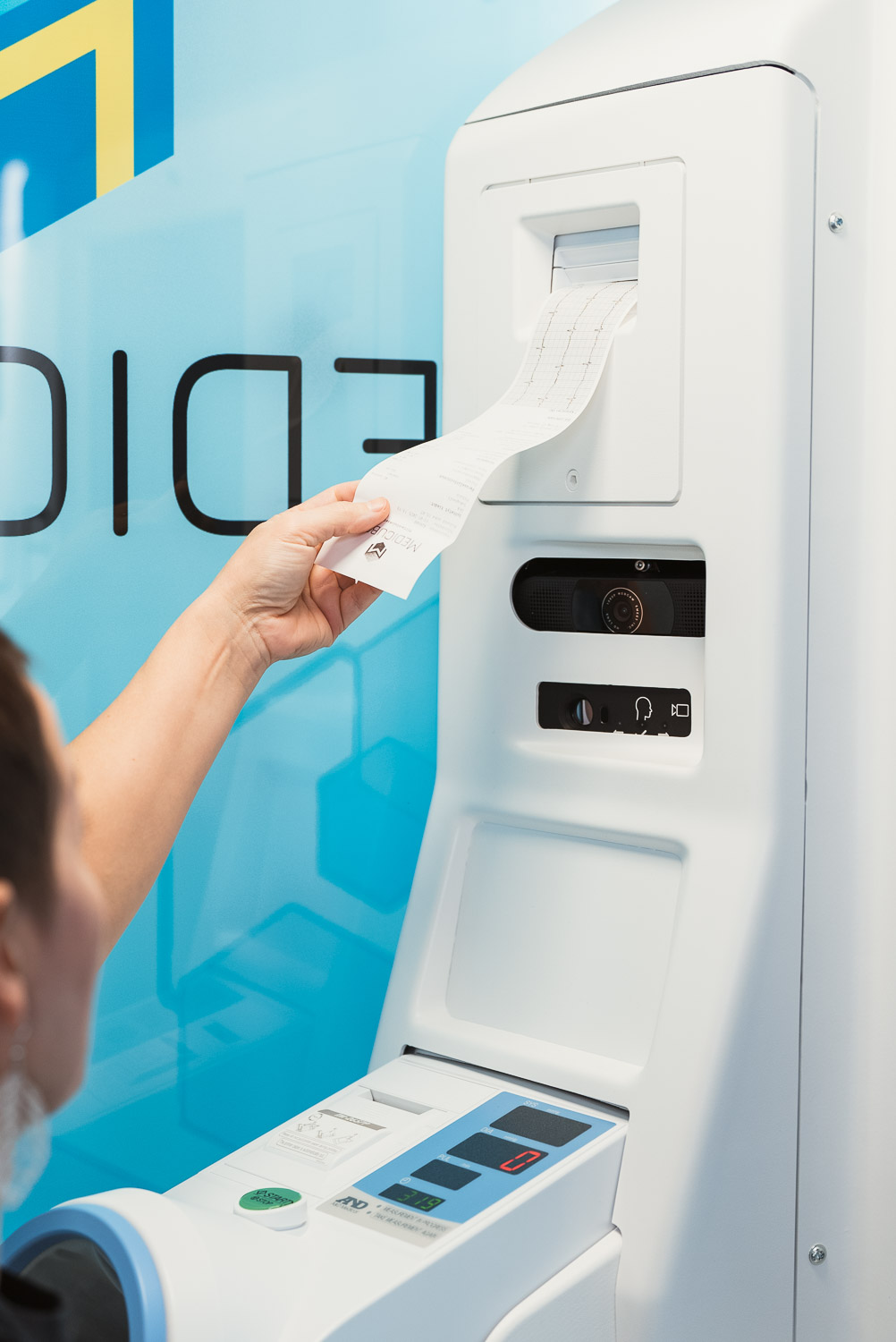We use cookies to help provide you with the best possible online experience.
By using this site, you agree that we may store and access cookies on your device. Cookie policy.
Cookie settings.
Functional Cookies
Functional Cookies are enabled by default at all times so that we can save your preferences for cookie settings and ensure site works and delivers best experience.
3rd Party Cookies
This website uses Google Analytics to collect anonymous information such as the number of visitors to the site, and the most popular pages.
Keeping this cookie enabled helps us to improve our website.
MedicubeX
Now Available On-Site – Try the MedicubeX eHealth Station Today!
See How Your Health Is Really Doing – Before Your Body Tells You
You want to know where you stand- to understand your health before problems arise, to get reassurance when things feel uncertain, or to face the difficult truth so you can take action.
The MedicubeX eHealth Station gives you that power. In just a few minutes, you can check your vital signs, assess your cardiovascular and diabetes risk, and gain clear, actionable insights into your wellbeing- all without waiting for an appointment.
Whether you’re a busy professional, managing a long-term condition, starting a fitness journey, or simply curious about how your body is doing, MedicubeX helps you stay informed and in control.
We’re proud to be the first in the UK to offer this innovative technology- part of our mission to make healthcare more proactive, personalised, and accessible for everyone.
What is MedicubeX?
MedicubeX revolutionises healthcare by enabling efficient access to vital sign measurements. The eHealth Station offers a comprehensive range of measurements, including:
- Body Temperature
- Blood Pressure
- Pulse Rate
- Body Composition (Body Fat, Basal Metabolic Rate)
- AGE Reader (Risk of Cardiovascular Diseases and Type 2 Diabetes)
- Respiratory Rate
- ECG (Heart Rate Variability, Heart Rate, Rhythm Analysis, Arrhythmia Detection)
- Pulse Oximeter (SpO₂)
- Weight
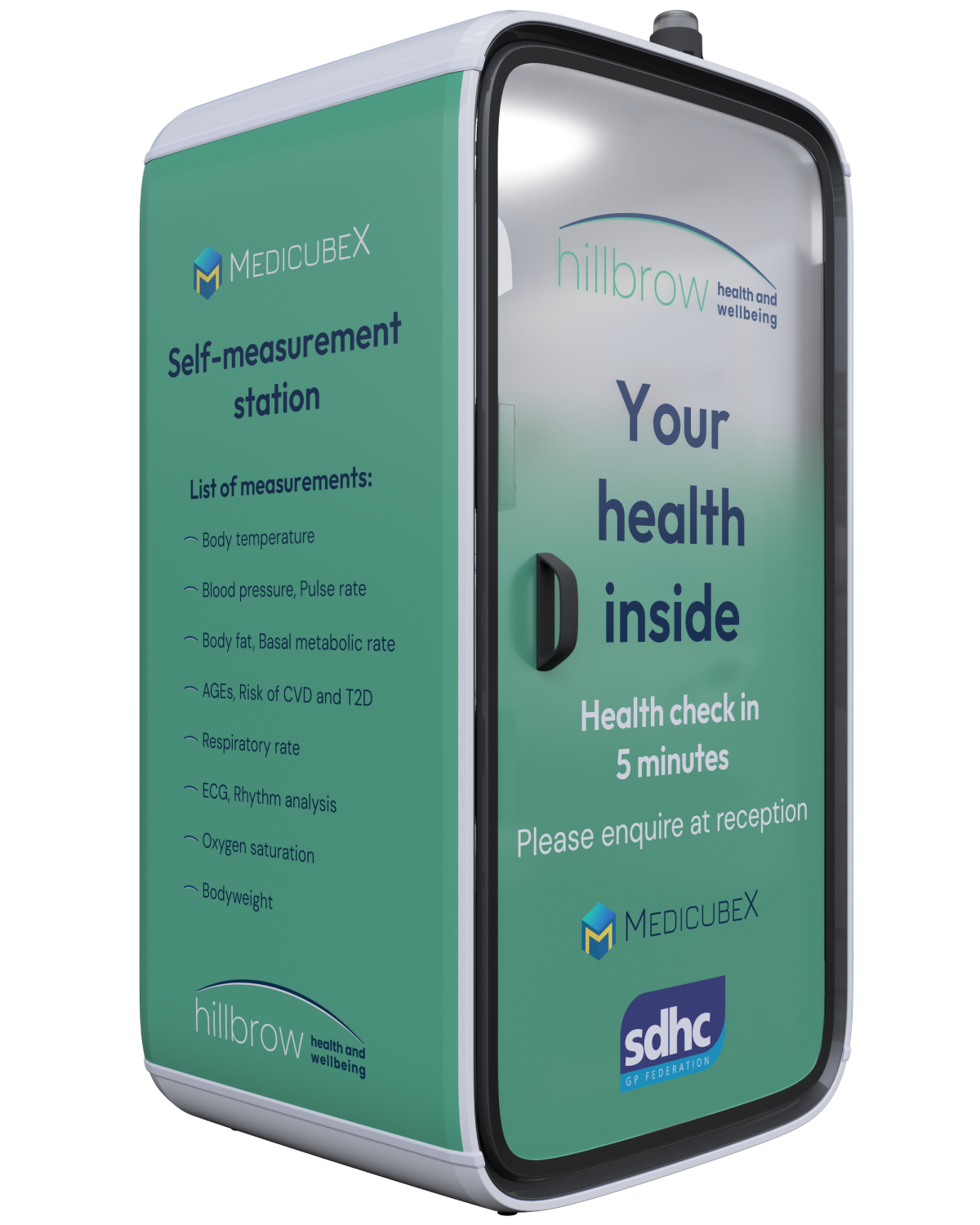
Packages Available
- Enhanced Health MOT – £25.99
- Includes full MedicubeX scan
- Results reviewed by a GP within 5 working days
- Follow-up discussion included for personalised insights
2. Basic Health MOT – £12.99
- Self-service scan using the MedicubeX eHealth Station
- Instant results on key health metrics
- No GP review included
No booking needed- just pop in and pay at the front desk before using the machine!
Reference Values
For accurate health monitoring, it's essential to understand the reference values for various measurements. Below are the reference values based on NICE guidelines:
Blood Pressure
- Stage 1 Hypertension: 140/90 mmHg
- Stage 2 Hypertension: 160/100 mmHg
- Severe Hypertension: 180/120 mmHg
- Target for individuals under 80: <140/90 mmHg
- Target for individuals over 80: <150/90 mmHg
The first number indicates blood pressure during heartbeats, and the second number indicates blood pressure between beats. Blood pressure is classified based on the higher value. The target blood pressure for everyone is below 135/85 mmHg, but an individual’s target may be lower due to conditions such as heart or kidney disease. Any significantly abnormal value should be re-measured. The interpretation of abnormal results depends on the overall context (age, gender, underlying conditions, etc.).
Elevated blood pressure should always be treated unless a different target has been established in consultation with a doctor.
Heart Rate
- Low heart rate: under 60 beats per minute
- Normal heart rate: 60–100 beats per minute
- Elevated heart rate: over 100 beats per minute
Resting heart rate varies widely depending on situations and individuals. Factors such as age, sex, physical fitness, hereditary factors, and emotional state can affect it. In a healthy adult, the resting heart rate can be below 60 beats per minute without indicating illness.
Any significantly abnormal value should be re-measured. The interpretation of abnormal results depends on the overall context (age, sex, underlying conditions, etc.) and whether the person has symptoms.
SpO₂ Levels
- Normal: 95% – 100%
- Mild hypoxia: 90% - 94%
- Moderate hypoxia: 85% – 89%
- Severe hypoxia: below 85%
Oxygen saturation reflects the amount of oxygen carried by haemoglobin in the blood. An abnormal value below 95% may be related to an acute illness or a previously diagnosed lung disease. Nail polish or cold hands can cause falsely low results, so significantly abnormal values should be re-measured. If the result is consistently abnormal without a known underlying illness, it is advisable to consult a healthcare professional. The interpretation of abnormal results depends on known chronic conditions and whether the person has symptoms.
Body Temperature
- Low: below 35.4 °C
- Normal: 35.5 – 37.5 °C
- A high temperature (fever) is defined as 37.8 and above
Normal body temperature varies depending on the time of day and physical activity. Any significantly abnormal value should be re-measured.
AGE (Advanced Glycation End-products)
AGE is a measurement of sugar accumulation in the skin tissue as byproducts of sugar metabolism, known as glycation end-products. Factors such as metabolic disorders like diabetes and harmful stressors like smoking can contribute to the accumulation of these end-products in tissues, along with individual variation.
The AGE value increases with age due to the aging process. A significantly high AGE value, relative to age, independently predicts an increased risk of developing conditions such as cardiovascular diseases and diabetes. If a person already has diagnosed diabetes, a high AGE value predicts a higher risk of complications. The AGE value does not replace other measurements used to assess the risks and treatment of cardiovascular diseases.
An unexpectedly high AGE value may indicate undiagnosed and untreated diabetes, in which case blood tests may be necessary. AGE reflects sugar values over the last 5 years. The more familiar blood test, HbA1c, measures the accumulation of sugar in haemoglobin within red blood cells and reflects the average blood sugar level over approximately 2 to 3 months.
Technically, the AGE Reader measures skin autofluorescence using UV light, which has been shown to correlate with AGE levels. The accuracy of the measurement can be compromised or prevented by the use of creams, such as sunscreen, or strong skin pigmentation. If the result is significantly abnormal, it is advisable to repeat the measurement. The interpretation of the result depends on the overall context (age, gender, underlying conditions, etc.) and individual goals. For more information about the measurement, refer to the manufacturer’s website.
This chart depicts average AGE values as a function of age. In addition to the average value, the values are shown with ±1 standard deviation.
The coloured areas indicate risk categories statistically correlated with AGE values based on age. When the value is lower than the average, the person’s risk, considering AGE measurement, is lower than the average for their age.
In the yellow area, the risk is slightly elevated, in the orange area, it is elevated, and in the red area, it is significantly elevated.
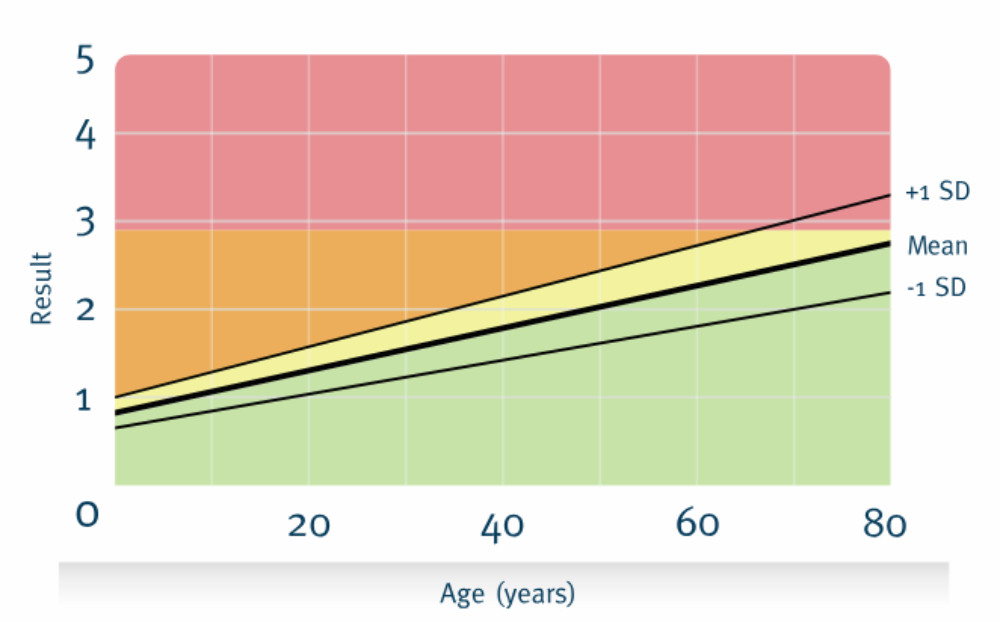
- Normal Group: No increased risk of cardiovascular diseases. If the AGE value is equal to or lower than the average for the age group, the person does not have an elevated risk of cardiovascular diseases based on this measurement. However, if the person is elderly and the value is above 2.5 (even if it is below or equal to the age group average), they may still have an increased risk considering their age.
- Risk Group I: Limited increase in the risk of cardiovascular diseases. If the AGE value is above the average but lower than +1 standard deviation (SD), it indicates a mildly increased risk of cardiovascular diseases relative to age.
- Risk Group II: Increased risk of cardiovascular diseases. If the measurement result exceeds +1 SD relative to age, the person has an elevated risk of cardiovascular diseases. In such cases, it is advisable to assess other risk factors such as blood pressure and lipid levels. Lifestyle factors and medication should be taken into account when evaluating the overall risk.
- Risk Group III: Significant risk of cardiovascular diseases. If the AGE Reader measurement result is 2.9 or higher, based on the research data, the individual has a high risk of cardiovascular diseases. It is recommended to assess and investigate other risk factors promptly to initiate necessary monitoring and treatment.
Average Values by Age Group: AGE values measured by the AGE Reader correlate with age. The table presents average values with standard deviations categorized by age groups.
Body fat
Body fat percentage is a measurement that indicates the percentage of body weight attributed to fat. The interpretation of body composition measurements is based on the individual’s sex, age, and the measured body fat percentage.
Body Fat Percentage Ranges.
Women
Age
18 - 39
40 - 59
over 60
Low
< 21%
< 23%
< 24%
Ideal
21 - 32.9%
23 - 34.9%
24 - 35.9%
Elevated
33 - 39%
35 - 40%
36 - 42%
High
> 39%
> 30%
> 42%
Men
Age
18 - 39
40 - 59
over 60
Low
< 8%
< 11%
< 13%
Ideal
8 - 18.9%
11 - 21.9%
13 - 24.9%
Elevated
19 - 25%
22 - 28%
25 - 30%
High
> 25%
> 28%
> 30%
How to Use the eHealth Station
Using the MedicubeX eHealth Station is simple and efficient:
1: Check-in
Enter the eHealth Station and follow the on-screen instructions.
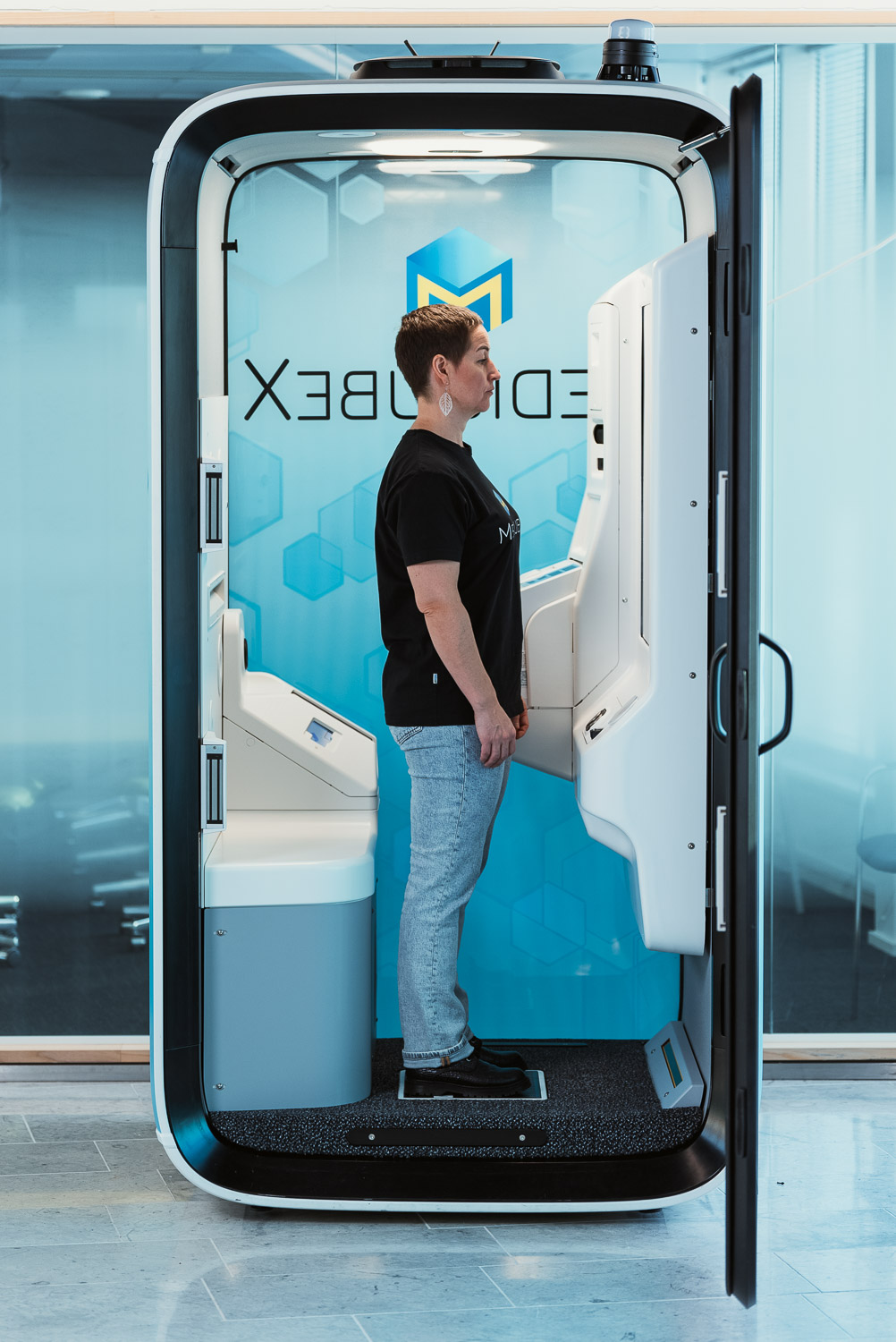
2: Measurements
The station will guide you through the process of measuring your vital signs.
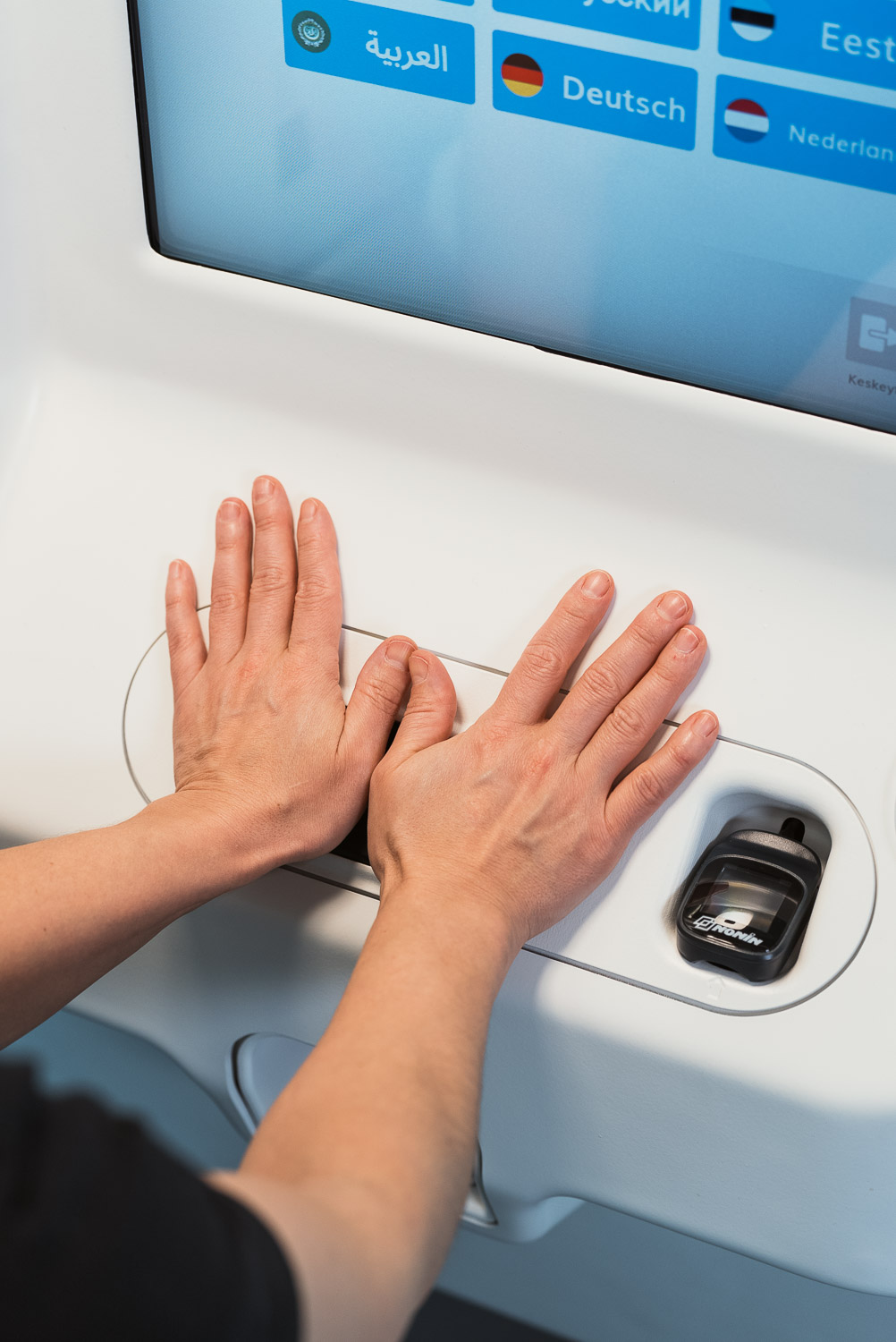
3: Results
Receive immediate feedback on your health status as seen below.
